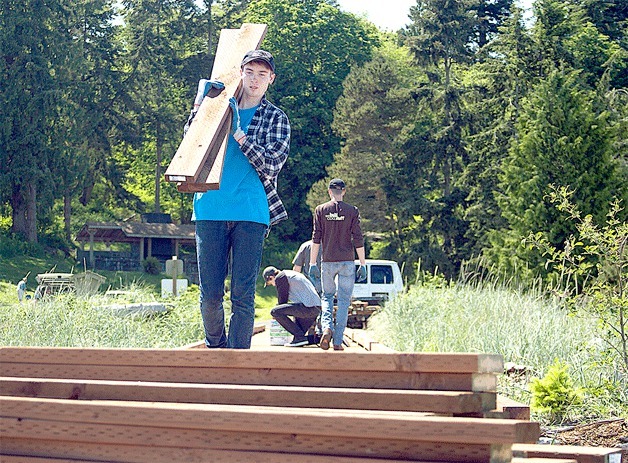Fairbank Construction interns don’t fetch coffee.
They actually build stuff.
Since February, over the course of 13 early-release Mondays, three high school students have been learning the ins-and-outs of project management, estimating, scheduling and requests for proposals, then putting their knowledge to the ultimate test.
They built a boardwalk at Fay Bainbridge Park.
Anybody who has been out to the park knows the serenity of the driftwood-daubed beach, the congenial camaraderie of visiting campers and the crystalline views of the Cascades and Washington’s biggest city.
What the salty shoreline is not known for, however, is its accessibility.
Log and sedge barricades pose problems for kayakers, who have to heft heavy equipment all the way from the parking lot, and the wheelchair-bound don’t stand a chance of making it down to the water.
There’s one path, a boardwalk constructed a few years ago by an island Eagle Scout, but community members have expressed the need for more, said Bainbridge Island Parks Foundation director Barb Trafton.
With all the permitting already in place, the parks foundation footed the bill — $3,000 for materials –—and the Fairbank team donated time and expertise to make the second boardwalk a reality.
John Hutchins, Mitch Young and Albert Ragsdale, the hardworking high schoolers responsible for the path, are participants in the Career-in Program, a combined venture from Fairbank Construction, the Bainbridge Island Rotary and the school district’s Career and Technical Education (CTE) department.
“Several years ago, we were talking about our industry — we’re struggling with getting new blood and getting young people interested in construction — and I suggested we reach out to the high school shop program,” said Fairbank vice president Sharen Borgias.
That reach didn’t pan out exactly as planned, but eventually led to a partnership. Fairbank hosted their first senior, Caitlin Williams, in 2015 for a 26-hour crash course in construction.
This spring, the three groups expanded the model, placing students at the fire department, the police department, Clark Construction and Modern Collision, where they cycled through different aspects of their host business every week.
Work-based learning coordinator Juliette Brown, who administers Career-in Program for the school district, is hoping that next year, the program will run in both the fall and the spring.
That all depends on the availability of employers, who, so far, have been very receptive.
“People are so willing to open their doors for our students,” she said. “They remember when they were in high school and the opportunities they did or didn’t have.”
For the career-curious teenager who doesn’t have a Monday afternoon to spare, CTE has a variety of other offerings to explore.
The Future Footprint series invites guest speakers in for lunch every month to talk shop and network with students. In April, a music producer and a commercial director showed up; previous editions have introduced professionals in the technology, health and criminal justice sectors.
A job shadowing day, held last month, allowed nine juniors to try on careers for half a day.
Brown, in her fourth year with the district but new to CTE, is still working on scaling that program up. Eventually, she’d like not only to place more students but also offer a series.
“Shadowing is by its very nature a quick look-see — you’re shopping,” she said. “I want kids to have the option to do more than one job shadow if they want to.”



